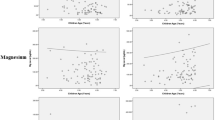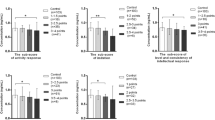Abstract
Autism spectrum disorder (ASD) is a type of neurodevelopmental disorder characterized mainly by qualitative deficiencies in social communication skills, accompanied by repetitive and restricted behavior patterns. This study was conducted to investigate the associations between the risk of ASD development in children and exposure to trace elements (arsenic (As), cadmium (Cd), chromium (Cr), cobalt (Co), copper (Cu), lead (Pb), nickel (Ni), and zinc (Zn)). Two groups of children, including 44 ASD and 35 typically developing (TD) children, were selected, and their fasting urine samples were obtained. The concentration levels of trace elements were assayed using ICP-MS. The results showed that as compared to the TD group, the concentration levels of As (p = 0.002) and Pb (p < 0.001) and also Cr (p < 0.001), Cu (p = 0.001), and Ni (p < 0.001) were significantly higher among ASD children. In terms of gender, boys with ASD showed elevated levels of Cr, Cu, Ni, and Pb, whereas the urine levels of As, Cr, Cu, Ni, and Pb were markedly higher among girls when compared to the non-ASD children. Under the logistic regression model, the risk difference for As, Co, Cr, Cu, Ni, Pb, and Zn remained significant when adjustment was applied for age and gender confounders.



Similar content being viewed by others
References
Abd Wahil MS, Ja’afar MH, Isa ZM (2021): Assessment of urinary lead (Pb) and essential trace elements in autism spectrum disorder: a case-control study among preschool children in Malaysia. Biol Trace Element Res 200, 97-121
Adams JB, Audhya T, McDonough-Means S, Rubin RA, Quig D, Geis E, Gehn E, Loresto M, Mitchell J, Atwood S (2013) Toxicological status of children with autism vs. neurotypical children and the association with autism severity. Biol Trace Element Res 151:171–180
Adams J, Howsmon DP, Kruger U, Geis E, Gehn E, Fimbres V, Pollard E, Mitchell J, Ingram J, Hellmers R (2017) Significant association of urinary toxic metals and autism-related symptoms—a nonlinear statistical analysis with cross validation. PloS one 12:e0169526
Akyuzlu DK, Kayaalti Z, Soylemez E, Soylemezoglu T (2014) Association between autism and arsenic, lead, cadmium, manganese levels in hair and urine. J Pharm Pharmacol 2:140
Albizzati A, More L, Di Candia D, Saccani M, Lenti C (2012) Normal concentrations of heavy metals in autistic spectrum disorders. Minerva Pediatr 64:27–31
Al-Farsi YM, Waly MI, Al-Sharbati MM, Al-Shafaee MA, Al-Farsi OA, Al-Khaduri MM, Gupta I, Ouhtit A, Al-Adawi S, Al-Said MF (2013) Levels of heavy metals and essential minerals in hair samples of children with autism in Oman: a case–control study. Biol Trace Element Res 151:181–186
Baj J, Flieger W, Flieger M, Forma A, Sitarz E, Skórzyńska-Dziduszko K, Grochowski C, Maciejewski R, Karakuła-Juchnowicz H (2021) Autism spectrum disorder: trace elements imbalances and the pathogenesis and severity of autistic symptoms. Neurosci Biobehav Rev 1:117–132
Bhat S, Acharya UR, Adeli H, Bairy GM, Adeli A (2014) Autism: cause factors, early diagnosis and therapies. Rev Neurosci 25:841–850
Bjørklund G (2013) The role of zinc and copper in autism spectrum disorders. Acta Neurobiol Exp (Wars) 73:225–236
Bjørklund G, Skalny AV, Rahman MM, Dadar M, Yassa HA, Aaseth J, Chirumbolo S, Skalnaya MG, Tinkov AA (2018) Toxic metal (loid)-based pollutants and their possible role in autism spectrum disorder. Environ Res 166:234–250
Blaurock-Busch E, Amin OR, Rabah T (2011) Heavy metals and trace elements in hair and urine of a sample of Arab children with autistic spectrum disorder. Maedica 6:247
Bölte S, Girdler S, Marschik PB (2019) The contribution of environmental exposure to the etiology of autism spectrum disorder. Cell Mol Life Sci 76:1275–1297
Calabrese V, Giordano J, Ruggieri M, Berritta D, Trovato A, Ontario M, Bianchini R, Calabrese E (2016) Hormesis, cellular stress response, and redox homeostasis in autism spectrum disorders. J Neurosci Res 94:1488–1498
Crăciun EC, Bjørklund G, Tinkov AA, Urbina MA, Skalny AV, Rad F, Dronca E (2016) Evaluation of whole blood zinc and copper levels in children with autism spectrum disorder. Metab Brain Dis 31:887–890
Dickerson AS, Rahbar MH, Bakian AV, Bilder DA, Harrington RA, Pettygrove S, Kirby RS, Durkin MS, Han I, Moyé LA (2016) Autism spectrum disorder prevalence and associations with air concentrations of lead, mercury, and arsenic. Environ Monitoring assessment 188:1–15
El-Ansary A, Bjørklund G, Tinkov AA, Skalny AV, Al Dera H (2017) Relationship between selenium, lead, and mercury in red blood cells of Saudi autistic children. Metab Brain Dis 32:1073–1080
Eqani SAMAS, Khuram F, Alamdar A, Tahir A, Shah STA, Nasir A, Javed S, Bibi N, Hussain A, Rasheed H (2020) Environmental exposure pathway analysis of trace elements and autism risk in Pakistani children population. Sci Total Environ 712:136471
Fiłon J, Ustymowicz-Farbiszewska J, Krajewska-Kułak E (2020) Analysis of lead, arsenic and calcium content in the hair of children with autism spectrum disorder. BMC Public Health 20:1–8
Fuentes-Albero M, Puig-Alcaraz C, Cauli O (2015) Lead excretion in Spanish children with autism spectrum disorder. Brain Sci 5:58–68
Imbriani G, Panico A, Grassi T, Idolo A, Serio F, Bagordo F, De Filippis G, De Giorgi D, Antonucci G, Piscitelli P (2021) Early-life exposure to environmental air pollution and autism spectrum disorder: a review of available evidence. Int J Environ Res Public Health 18:1204
Jan AT, Azam M, Siddiqui K, Ali A, Choi I, Haq QM (2015) Heavy metals and human health: mechanistic insight into toxicity and counter defense system of antioxidants. Int J Mol Sci 16:29592–29630
Kloke JD, McKean JW (2012) Rfit: rank-based estimation for linear models. R J 4:57
Li S-o, Wang J-l, Bjørklund G, Zhao W-n, Yin C-h (2014) Serum copper and zinc levels in individuals with autism spectrum disorders. Neuroreport 25:1216–1220
Meguid NA, Anwar M, Bjørklund G, Hashish A, Chirumbolo S, Hemimi M, Sultan E (2017) Dietary adequacy of Egyptian children with autism spectrum disorder compared to healthy developing children. Metab Brain Disease 32:607–615
Mohammadi MR, Ahmadi N, Khaleghi A, Zarafshan H, Mostafavi S-A, Kamali K, Rahgozar M, Ahmadi A, Hooshyari Z, Alavi SS (2019) Prevalence of autism and its comorbidities and the relationship with maternal psychopathology: a national population-based study. Arch Iranian Med 22:546–553
Mostafa GA, Bjørklund G, Urbina MA, Al-Ayadhi LY (2016) The positive association between elevated blood lead levels and brain-specific autoantibodies in autistic children from low lead-polluted areas. Metab Brain Disease 31:1047–1054
Nevison CD (2014) A comparison of temporal trends in United States autism prevalence to trends in suspected environmental factors. Environ Health 13:1–16
Obrenovich ME, Shamberger RJ, Lonsdale D (2011) Altered heavy metals and transketolase found in autistic spectrum disorder. Biol Trace Element Res 144:475–486
Ousley O, Cermak T (2014) Autism spectrum disorder: defining dimensions and subgroups. Current Dev Disorders Reports 1:20–28
Priya MDL, Geetha A (2011) Level of trace elements (copper, zinc, magnesium and selenium) and toxic elements (lead and mercury) in the hair and nail of children with autism. Biol Trace Element Res 142:148–158
Rahbar MH, Samms-Vaughan M, Lee M, Zhang J, Hessabi M, Bressler J, Bach MA, Grove ML, Shakespeare-Pellington S, Beecher C (2020) Interaction between a mixture of heavy metals (lead, mercury, arsenic, cadmium, manganese, aluminum) and GSTP1, GSTT1, and GSTM1 in relation to autism spectrum disorder. Res Autism Spectrum Disorders 79:101681
Roberts AL, Lyall K, Hart JE, Laden F, Just AC, Bobb JF, Koenen KC, Ascherio A, Weisskopf MG (2013) Perinatal air pollutant exposures and autism spectrum disorder in the children of Nurses’ Health Study II participants. Environ Health Perspect 121:978–984
Saghazadeh A, Rezaei N (2017) Systematic review and meta-analysis links autism and toxic metals and highlights the impact of country development status: higher blood and erythrocyte levels for mercury and lead, and higher hair antimony, cadmium, lead, and mercury. Prog Neuro-Psychopharmacol Biol Psychiat 79:340–368
Santos JX, Rasga C, Vicente AM (2021) Exposure to xenobiotics and gene-environment interactions in autism spectrum disorder: a systematic review. . In: Michael F (Editor), Autism spectrum disorder: profile, heterogeneity, neurobiology and intervention. doi: https://doi.org/10.5772/intechopen.95758. BoD – Books on Demand, pp. 133
Skalny AV, Simashkova NV, Klyushnik TP, Grabeklis AR, Radysh IV, Skalnaya MG, Tinkov AA (2017) Analysis of hair trace elements in children with autism spectrum disorders and communication disorders. Biol Trace Element Res 177:215–223
Sulaiman R, Wang M, Ren X (2020) Exposure to aluminum, cadmium, and mercury and autism spectrum disorder in children: a systematic review and meta-analysis. Chem Res Toxicol 33:2699–2718
Vakilizadeh N, Abedi A, Mohseni Ezhiyeh A (2017) Investigating validity and reliability of early screening for autistic traits-Persian version (ESAT-PV) in toddlers. Arch Rehabilit 18:182–193
Weitlauf AS, McPheeters ML, Peters B, Sathe N, Travis R, Aiello R, Williamson E, Veenstra-VanderWeele J, Krishnaswami S, Jerome R (2014) Therapies for children with autism spectrum disorder: behavioral interventions update. AHRQ Comparative Effectiveness Reviews. No. 137. Rockville (MD): Agency for Healthcare Research and Quality (US); 2014 Aug. Report No: 14-EHC036-EF
Yao Y, Walsh WJ, McGinnis WR, Praticò D (2006) Altered vascular phenotype in autism: correlation with oxidative stress. Arch Neurol 63:1161–1164
Yasuda H, Yasuda Y, Tsutsui T (2013) Estimation of autistic children by metallomics analysis. Scientific Reports 3:1–8
Yorbik Ö, Kurt İ, Haşimi A, Öztürk Ö (2010) Chromium, cadmium, and lead levels in urine of children with autism and typically developing controls. Biol Trace Element Res 135:10–15
Yorbik O, Sayal A, Akay C et al (2002) Investigation of antioxidant enzymes in children with autistic disorder. Prostaglandins Leukot Essent Fatty Acids 67(5):341–343
Acknowledgements
We would like to acknowledge the assistance of the Medical Toxicology and Drug Abuse Research Center (MTDRC) and also Clinical Research Development Unit of Imam Reza Hospital at the Birjand University of Medical Sciences. Special thanks to Dr. Lukasz J. Binkowski and Dr. Martyna Błaszczyk for their assistance in improving the manuscript. In addition, our sincere appreciation goes to all patients who participated in this study.
Availability of data and materials
The datasets used and/or analyzed during the current research are available from the corresponding author on request.
Funding
This study was supported by the Birjand University of Medical Sciences (Grant number: 1398.4868).
Author information
Authors and Affiliations
Contributions
MR and BM were the overall coordinators. MR, AR, AE, SN, NA, and BM contributed to the design of the study, interpretation of the results, and drafting of the manuscript. MR and AR conducted the data collection. NA did data analysis. All authors have read and approved the final version of the manuscript.
Corresponding author
Ethics declarations
Ethics approval and consent to participate
This study was approved by the research and ethics committee of Birjand University of Medical Sciences (no. IR.BUMS.REC.1397.204).
Consent for publication
Not applicable
Competing interests
The authors declare no competing interests.
Additional information
Responsible editor: Lotfi Aleya
Publisher’s note
Springer Nature remains neutral with regard to jurisdictional claims in published maps and institutional affiliations.
Rights and permissions
About this article
Cite this article
Rezaei, M., Rezaei, A., Esmaeili, A. et al. A case–control study on the relationship between urine trace element levels and autism spectrum disorder among Iranian children. Environ Sci Pollut Res 29, 57287–57295 (2022). https://doi.org/10.1007/s11356-022-19933-1
Received:
Accepted:
Published:
Issue Date:
DOI: https://doi.org/10.1007/s11356-022-19933-1




